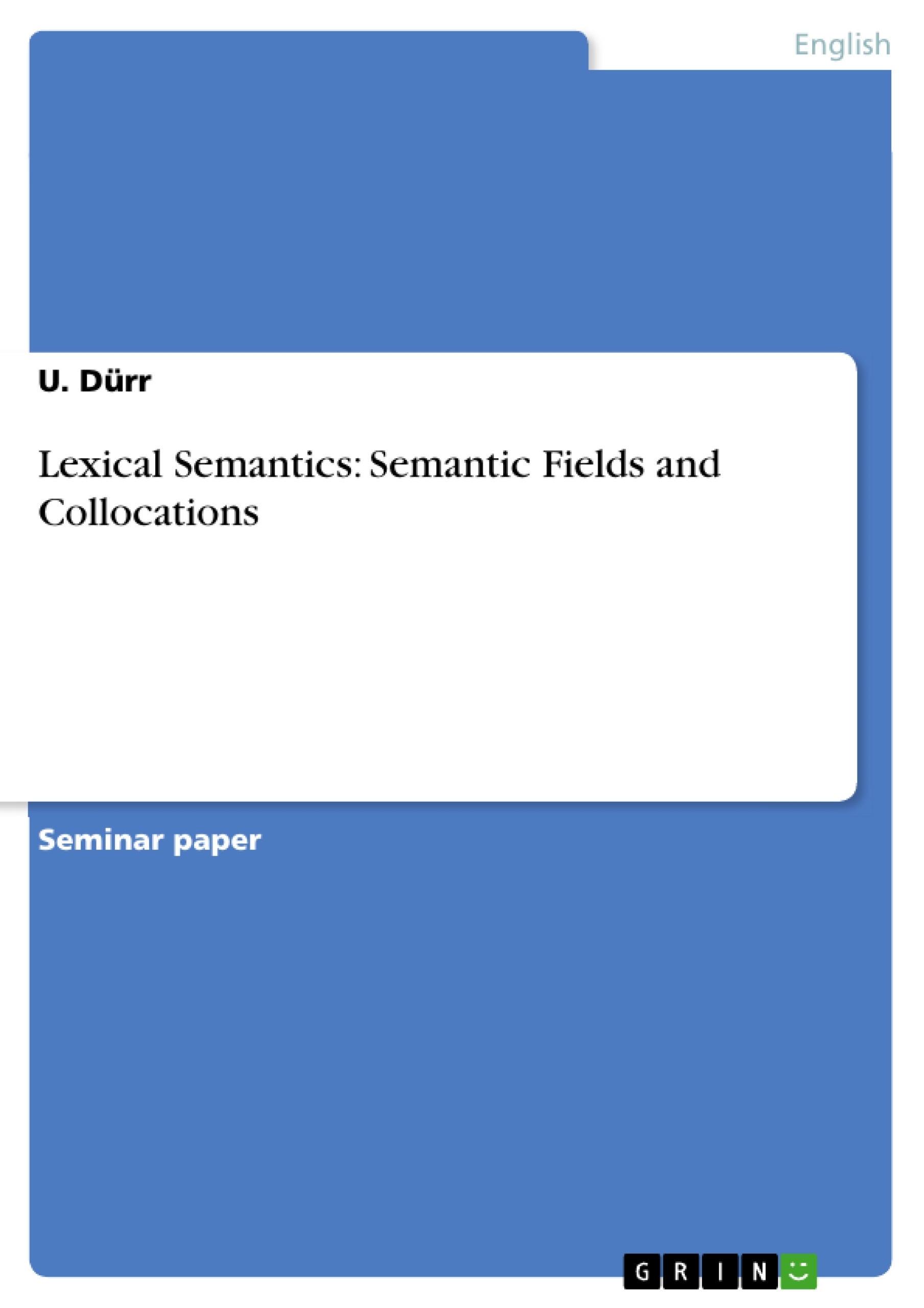This term paper will focus on an aspect of lexical semantics: interrelations of word meanings on a paradigmatic, as well as on a syntagmatic level.
Starting with paradigmatic word relations, the paper will cover the topic of semantic fields first, describing the history of how this aspect was introduced to semantics and explaining the theoretical background behind the topic. Furthermore the development of different theories from the first structuralist approaches in the 1930s to the more recent approaches of cognitive semantics and the frame theory will be outlined.
In the second part, the paper will cover the topic of syntagmatic relations of word meanings, namely collocations. The term will be defined and examples will be mentioned, before dealing with the important concepts of ‘statistically significant’ and ‘institutionalized collocations’. Finally there will be a demarcation to the phenomenon of idioms, before the term paper finishes with a conclusion about the whole topic.
Table of Contents
- 1. Introduction
- 2. Paradigmatic relations: semantic fields
- 2.1 The beginning: structuralist approaches
- 2.2 Further development: cognitive approaches
- 3. Syntagmatic relations: collocations
- 3.1 Collocations: definition and examples
- 3.2 Statistically significant and institutionalized collocations
- 3.3 Idioms versus collocations
- 4. Conclusion
Objectives and Key Themes
This term paper aims to explore the interrelations of word meanings, focusing on two key types of lexical semantic relations: paradigmatic and syntagmatic. It examines the historical development of theories concerning these relations, from structuralist approaches to more recent cognitive perspectives.
- Paradigmatic relations and semantic fields
- Syntagmatic relations and collocations
- Development of lexical field theory
- Cognitive semantic approaches to lexical relations
- Distinction between collocations and idioms
Chapter Summaries
1. Introduction: This chapter introduces lexical semantics as a branch of linguistics concerned with word meaning and its interrelations. It emphasizes Firth's idea of understanding word meaning through its associations with other words and introduces Saussure's distinction between paradigmatic and syntagmatic relations as the framework for the paper's analysis of semantic fields and collocations.
2. Paradigmatic relations: semantic fields: This chapter delves into the concept of semantic fields, illustrating paradigmatic relations where words are contrasted or substituted. It begins with Trier's influential structuralist work on lexical fields in German, highlighting his view of word meaning based on its relation to other words within a structured system. The chapter then critiques Trier's approach, examining later developments within structuralism and its limitations. It sets the stage for the discussion of cognitive semantic approaches in the following subchapter.
3. Syntagmatic relations: collocations: This section explores syntagmatic relations, focusing on collocations – the habitual combinations of words. It defines collocations, provides examples, and distinguishes between statistically significant and institutionalized collocations. The chapter then differentiates collocations from idioms, emphasizing the fixed nature of idioms compared to the more flexible nature of collocations, thus providing a complete picture of word relationships based on their context and usage.
Keywords
Lexical semantics, semantic fields, collocations, paradigmatic relations, syntagmatic relations, structuralism, cognitive semantics, lexical field theory, idioms, word meaning, linguistic relations.
Frequently Asked Questions: A Comprehensive Language Preview
What is the topic of this language preview?
This preview covers lexical semantics, focusing on paradigmatic and syntagmatic relations between words. It explores semantic fields and collocations, examining their development through structuralist and cognitive linguistic perspectives.
What are the key themes explored in this preview?
The key themes include paradigmatic relations and semantic fields, syntagmatic relations and collocations, the historical development of lexical field theory, cognitive semantic approaches to lexical relations, and the distinction between collocations and idioms.
What is covered in Chapter 1 (Introduction)?
Chapter 1 introduces lexical semantics, emphasizing Firth's concept of understanding word meaning through associations. It establishes Saussure's distinction between paradigmatic and syntagmatic relations as the framework for analyzing semantic fields and collocations.
What is discussed in Chapter 2 (Paradigmatic relations: semantic fields)?
Chapter 2 explores semantic fields, illustrating paradigmatic relations (where words are contrasted or substituted). It begins with Trier's structuralist work on lexical fields, critiques his approach, and transitions to cognitive semantic approaches.
What does Chapter 3 (Syntagmatic relations: collocations) cover?
Chapter 3 focuses on syntagmatic relations, specifically collocations (habitual word combinations). It defines collocations, provides examples, distinguishes between statistically significant and institutionalized collocations, and differentiates collocations from idioms.
What are the main objectives of this text?
The main objective is to explore the interrelations of word meanings, concentrating on paradigmatic and syntagmatic lexical semantic relations. It aims to examine the historical development of theories concerning these relations from structuralist to cognitive perspectives.
What are the key words associated with this text?
Key words include lexical semantics, semantic fields, collocations, paradigmatic relations, syntagmatic relations, structuralism, cognitive semantics, lexical field theory, idioms, word meaning, and linguistic relations.
What is the overall structure of this language preview?
The preview provides a table of contents, outlines the objectives and key themes, offers chapter summaries, and lists keywords. This structured approach facilitates a comprehensive understanding of the text's content.
What types of linguistic approaches are discussed?
The preview discusses both structuralist and cognitive semantic approaches to understanding lexical relations and word meaning.
For whom is this language preview intended?
This preview is intended for academic use, supporting the analysis of themes in a structured and professional manner.
- Quote paper
- U. Dürr (Author), 2011, Lexical Semantics: Semantic Fields and Collocations, Munich, GRIN Verlag, https://www.grin.com/document/186932




